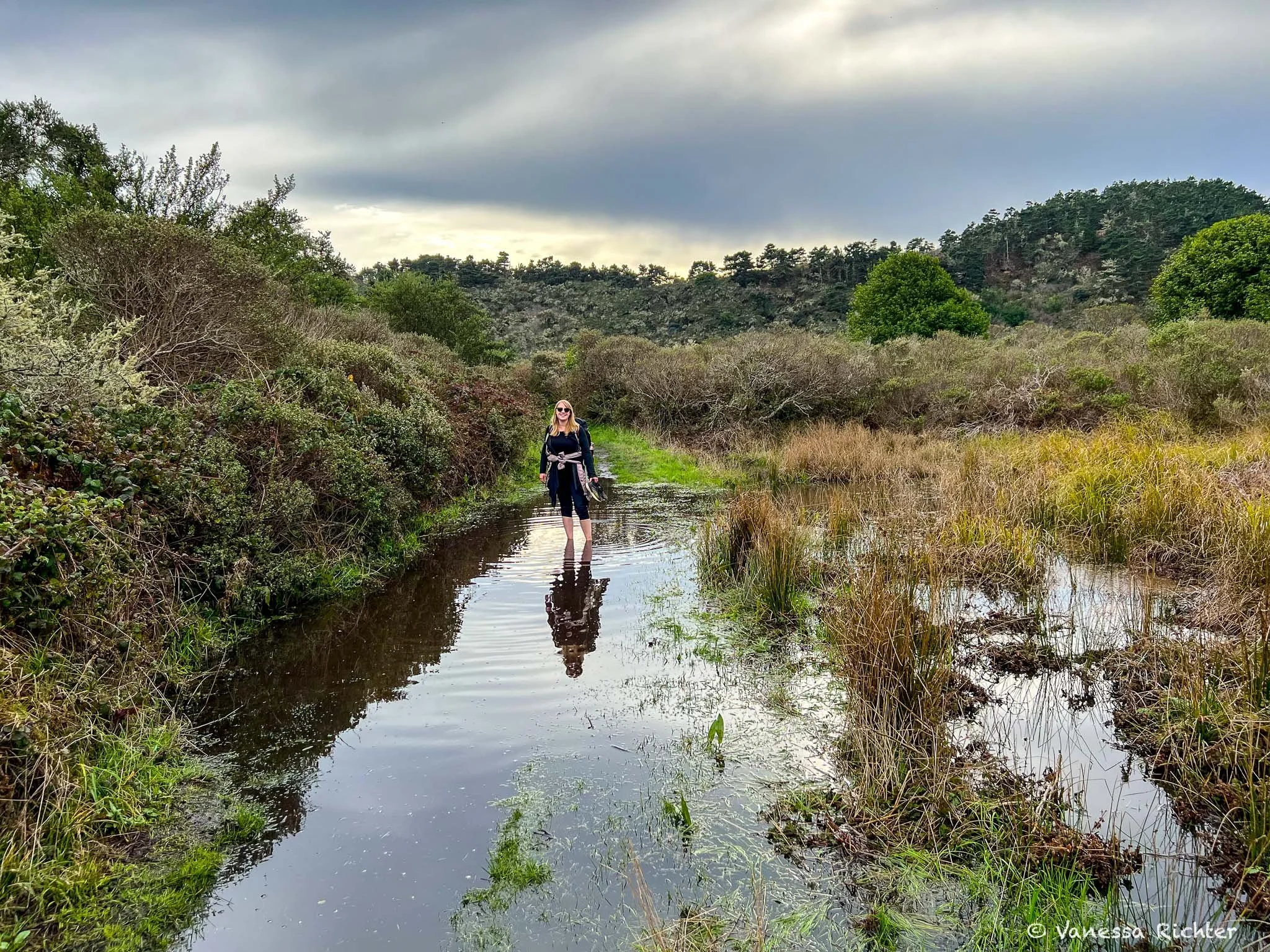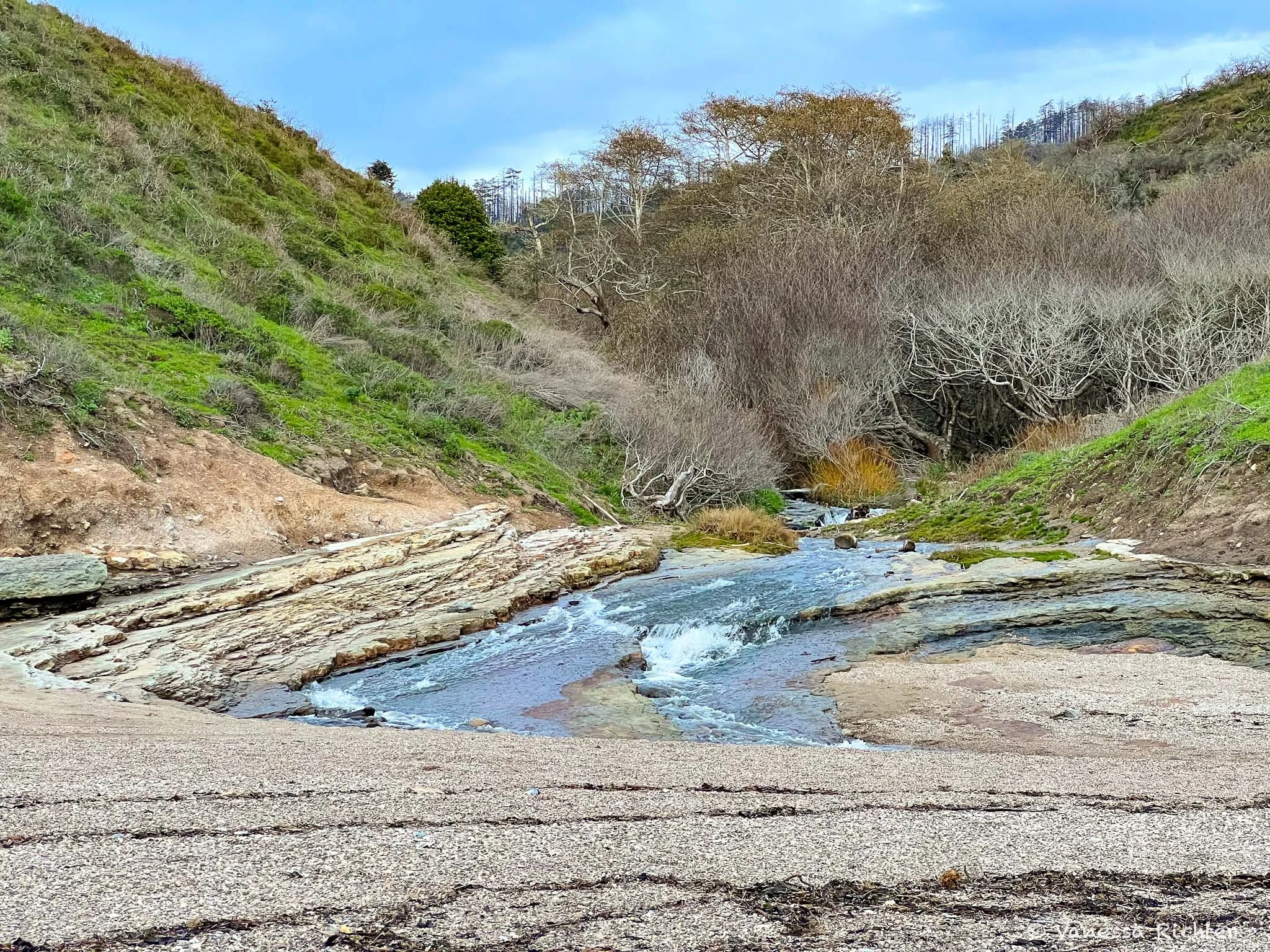Backpacking and Tide Pooling at Point Reyes National Seashore in Winter
Winters on the California coast are mild, with temperatures not differing much from summer. In fact, a dry, sunny winter day can feel warmer than one of the many foggy, windy summer days. While the region often experiences much-needed rain after a bone-dry summer, there are also plenty of clear, summer-like days during the winter months. In January, after a stretch of rain, we seized the opportunity to head out to Point Reyes National Seashore for a backpacking adventure to Coast Campground and Santa Maria Beach.
In this article, you’ll discover how amazing a winter backpacking and camping trip can be at Point Reyes National Seashore, along with practical tips on tide pooling and campgrounds.
As we pulled into the small lot at the Laguna Trailhead, a parking spot magically opened up just in time—it felt like a lucky start to our adventure. We left a note on the windshield in case anyone wondered about the ‘abandoned’ car, knowing it will be resting here overnight. The clouds hung low and moody, but the weather promised to stay dry, setting the stage for our little adventure under a soft, overcast sky. It was one of the few perfect January weekends for a backpacking trip! We followed the Laguna Trailhead, with the soil beneath our feet still wet but not too muddy. A light breeze swept through, making it surprisingly warm for January; a light sweater was more than enough. It seemed like most day hikers had already returned to their cars as we couldn't hear or see anyone.
After a while, we walked up a gentle hill, and from a distance, we could make out something that appeared like a lake on the trail. Even though it had been dry for a few days, the large amount of rain couldn't be completely absorbed by the already drenched soil. We contemplated if there was a way around it, but the only way to keep our shoes dry was to take them off. Since it was warm enough, that was a pretty simple solution, so we chose to step out of our shoes and started wading through the water. The cold wet stroked our feet, submerging our legs a few inches into the cloudy water. The soaked sandy soil at the bottom of the lake felt quite fluffy and cozy. The depth was consistent throughout that big waterhole, yet a weird thing happened. Suddenly, the temperature changed. While the water was never freezing cold but rather chilly, it now felt like someone turned a heater on. A warm swell of water surrounded our feet now. Before we could wonder too much about it, we had already reached the opposite 'shore.' The ground seemed rather smooth, with only a few rocks, so we decided to keep our shoes off for now. This proved to be a good idea at first as we came across some more smaller and larger water holes.
We continued barefoot, prepared to cross more smaller or larger puddles. The soil was initially sandy, soggy, or grassy. At some point, it became rockier and drier, so we shook off the mud on our feet and put our shoes on again. The path then descended downhill for a while. On the ridges above us, we could make out some Tule Elks grazing—a beautiful scene!
After a short 2 mile hike, we reached the campground. Our campsite was located toward the very end of the path that lead us slightly uphill. It was bordered by many green bushes, behind which other campsites were also hidden. From our campsite, we could sometimes hear other campers talking to each other, but visually, the campsites were well-sheltered and private.
As it was about to get dark, we quickly set up camp and headed to the beach. I had checked the tide schedule beforehand and knew that there was a rocky area at the beach where, at low tide, one could observe marine life as it waited for the ocean to roll in again.
The walk from the campground to the beach led past a giant Eucalyptus tree, down a hill. At Santa Maria Beach, there weren’t many people, which made sense as the campground is hike-in only and doesn’t have many campsites. Some people gathered closer to the rocks to set up a campfire.
View toward Sculptured Beach, which includes the rocky area with tide pools.
The sun started to go down, and the big dark clouds tried to push themselves in front of the last rays of sunlight. We knew that we needed to hurry up if we still wanted to see the tide pools in the daylight. The rocky area further down the beach was visible from afar as there was nothing obstructing the view; therefore, it appeared closer than it actually was.
Our hurry was interrupted when we spotted a long-billed curlew wading through the water. When I see these birds, I always have to think of a kiwi — Weirdly enough, as I have never been to New Zealand, and, in many ways, they look pretty different too. Maybe it is the long, shallow beak in comparison to their head that my brain processes as a similarity? Or, it is simply the human desire to always compare things with each other, and that was the closest known ‘match’ that I could come up with. Whatever it is, it was magnificent to observe these birds feeding in the shallow ocean shoreline. They seemed to be pretty successful!
Along the shore, a long-billed curlew wades gracefully.
The sun was hurrying up to say goodbye for the night, and so we sped up our steps too. The rocky area came closer and closer. We crossed a small waterflow running into the ocean and then we could finally see the tide pools, that shelter so much marine life that is patiently waiting for the ocean waters to return. The puddles were bursting with life. Most apparent was the multitude of snails and mussels living within their miniature universe at this time. As we came here at a very low tide, there were also many rocks that were completey unsheltered from the water now, so we had to be very careful watching our steps, to avoid stepping on the many mussels and other tiny marine life.
With a last, weak pink-orange glow, the sun finally set in the horizon and disappeared.
A last glow of pink before the final trace of sun eventually disappeared.
Besides the countless snails and mussels, something else was there: so, so many sea stars. They glowed in orange and purple, most of them hidden towards the very bottom of rock surfaces where they found the most shelter from the air and sun. We also observed numerous sea anemones, many of which were covered in thick layers of sand, so that you could often only see a small circle of blue-green peeking through the brown mud.
A stunning sea star clings to a rocky surface.
Tide Pooling Essentials
Timing & How
- Tide pooling is only possible at low tide when receding water reveals ocean life usually submerged underwater.
- I recommend visiting 1–2 hours before the lowest tide. This timing allows ample time to explore while the tide is still receding, without worrying about incoming water.
- Marine life can be found in puddles or on rock surfaces. Different areas of the intertidal zones are home to different species. Sea anemones and sea stars often hide in the shade, so crouch down and look towards the bottom of rocks to spot them.
Explore & Contribute: iNaturalist
- iNaturalist is a fantastic resource to explore local tide pooling sightings.
- Search for particular species or get a full overview of marine life others have spotted in a particular area.
- Contribute your own observations via the app or website and help build community science data that supports conservation efforts.
Guidelines for Responsible & Safe Tide Pooling
- Walk gently and avoid stepping on rocks that host marine life, including small organisms like mussels.
- Respect wildlife and habitats by not removing or touching anything in tide pools or on rock surfaces. Disturbing these habitats can cause irreversible damage or stress to marine life.
- Avoid turning over rocks, as this disturbs the marine life living underneath.
- Watch for incoming tides to avoid getting stranded. The difference between low and high tide can be several feet, submerging areas accessible during low tide.
- Observe wet vs. dry areas to gauge where water reaches at high tide.
- Rocks can be extremely slippery. Wear shoes with good grip.
Night at the Campground
When we arrived back at the campground, it was completely dark. However, the moon was shining brightly in the sky, so it wasn't pitch black. After having a simple dinner consisting of noodles in pouches, with the chilly wind picking up, we decided it was time to make ourselves cozy in the tent. First, we headed to the bathroom, though — on our way, we suddenly saw many bright eyes gazing at us! There were so many elk feeding on the bushes, wandering around the campground in the dark. They didn't seem to bother the humans they shared their habitat with. We passed them, got ready for bed, and went back to our tent, where we quickly found sleep, earlier than usual when artificial light would keep us awake.
Even though it was mid-January, it wasn’t cold at all that night. However, the wind blasted heavily at our tent at times, and despite a clear sky prediction in the weather forecast, raindrops were falling heavily on our tent from time to time. Because of this, I was awake a lot but found myself quite refreshed the next morning.
The next morning: The sun has just risen, and the clear sky was only interrupted by a few clouds.
Our campsite on the Coast Campground at Point Reyes.
After breakfast, we packed everything together and retraced our steps from the day before. This time, we encountered numerous day hikers along the way — and a snake that stretched across the width of the trail. We paused for the snake to move into the grasses at the side, but it remained still until we approached closer and closer. Only when we had come within a very close distance did it make a sudden move and vanish into the bushes at the side of the trail.
In the early afternoon, we returned to the parking lot and found our car exactly as we had left it. After stowing our bags in the trunk, we set out to explore more of Point Reyes. There is so much to see!
Know Before You Go: Backpacking at Point Reyes in Winter
Hike-In Campgrounds
Coast Campground
- Easy access to Santa Maria Beach (220 yards) and tide pools (~720 yards southeast toward Sculptured Beach).
- Shortest way in is via the 1.8-mile slightly uphill hike on the Laguna & Fire Lane Trails, starting at the Laguna Trailhead.
- 12 regular sites & 2 group sites.
Sky Campground
- Located on the western side of Mount Wittenberg at an elevation of 1025 feet with views of Point Reyes, Drakes Bay, and the Pacific Ocean (when the sky is clear).
- Steep 4-mile hike down to the beach.
- Easiest and shortest approach is a 1.4-mile moderate uphill hike from the Sky Trailhead via Sky Trail.
- 11 regular sites & 1 group site.
Wildcat Campground
- Situated in a spacious meadow atop a bluff with panoramic ocean views and a brief stroll to the beach.
- 6.3-mile hike from Bear Valley Trailhead or 5.5-mile hike from the Palomarin Trailhead.
- 5 regular sites & 3 group sites.
Glen Campground
- Located deep within a wooded valley, with the closest beach being 2.5 miles away.
- Shortest route is from the Bear Valley Trailhead via a 4.6-mile hike.
- No groups (7+ people), horses, or pack animals allowed.
- 12 regular campsites.
All Campgrounds
- Require a Reservation.
- Potable water, food storage lockers, and vault toilets available.
- No charcoal grills (permanently removed in 2022) or showers.
Safety
- Trails can be muddy in Winter and have some larger puddles.
- Check the weather forecast and avoid going when a storm is predicted.
Keep Reading
Follow the Adventure
Latest on the Blog
Search
If you enjoy my content, please consider supporting my work
Your support helps me to pour my time and soul into Venture Beyond The Picture while keeping it clutter free. Every little bit means a lot to me. I am beyond grateful for every contribution.













